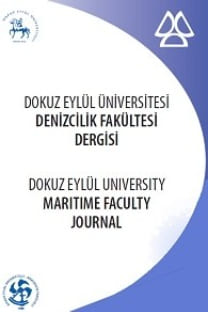GEMES Project: Vocational Seamanship Training Program Supported by European Union
Gençlerin istihdamı, mesleki gemiadamı eğitimi, avrupa birliği projesi
GEMES PROJECT: VOCATIONAL SEAMANSHIP TRAINING PROGRAM SUPPORTED BY EUROPEAN UNION
___
- Deniz Haber. 2011. “Denizcilik Sektöründe 7 Bin Gemiadamı Açığı”.
- http://www. denizhaber.com/HABER/8536/2/. (Accessed 12 June
- -
- International Maritime Organization. 2011. “Tanker safety: the work
- of the International Maritime Organization”, Focus on IMO, United
- Kingdom, London.
- Marine Accidents Investigation Branch. 1999. “Annual Report”.
- http://www.maib.gov.uk/publications/annual_reports/annual_report_1
- cfm. (Accessed 10 June 2011).
- The Central Finance and Contracts Unit. (2011).
- http://www.cfcu.gov.tr/ about.php ?Ing.=en &action=cfcu. (Accessed
- June 2011).
- Turkiye İstatistik Kurumu. (2008). “İşgücü İstatistikleri”.
- http://tuikrapor.tuik.gov.tr/reports. (Accessed 15 March 2008).
- Turkiye İstatistik Kurumu. (2011). “İşgücü İstatistikleri”.
- http://tuikrapor.tuik.gov.tr/reports. (Accessed 12 June 2011).
- ISSN: 1309-4246
- Yayın Aralığı: 2
- Başlangıç: 2009
- Yayıncı: Dokuz Eylul Üniversitesi Matbası
POZİTİF EMNİYET KÜLTÜRÜ TEMEL ÖĞELERİNİ ESAS ALAN KAZASAY OLAYLARI (NEAR MİSS) RAPORLAMA SİSTEMİ *
EVSEL İLAÇ ATIKLARININ TOPLANMASINDA TERSİNE LOJİSTİK AĞI ÜZERİNE BİR UYGULAMA
Özlem DOĞAN İPEKGİL, KADİR KIRDA
TURKISH SHIPOWNERS’ PERCEPTIONS OF THIRD PARTY SHIP MANAGEMENT COMPANIES: A MARKET RESEARCH STUDY
TURKISH SHIPOWNERS' PERCEPTIONS OF THIRD PARTY SHIP MANAGEMENT COMPANIES: A MARKET RESEARCH STUDY
İSMAİL BİLGE ÇETİN, A. Güldem CERİT
GEMİ ACENTELERİNDE ÇALIŞANLARIN DEĞİŞİME KARŞI TUTUMUNDA BELİRSİZLİK VE GÖREV GÜVENSİZLİĞİNİN ETKİSİ
GEMES Project: Vocational Seamanship Training Program Supported by European Union
OĞUZ ATİK, SELÇUK NAS, ALİ CEMAL TÖZ, BURAK KÖSEOĞLU
Evsel İlaç Atıklarının Toplanmasında Tersine Lojistik Ağı Üzerine Bir Uygulama
Özlem İPEKGİL DOĞAN, Kadir KIRDA
CONCENTRATION AND COMPETITION OF CONTAINER PORTS IN TURKEY: A STATISTICAL ANALYSIS*
TÜRKİYE’DEKİ KONTEYNER LİMANLARINDA YOĞUNLAŞMA VE REKABET: İSTATİSTİKSEL BİR ANALİZ
